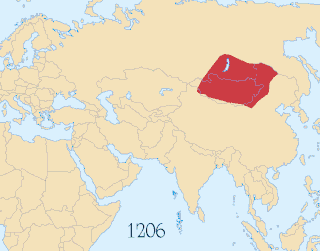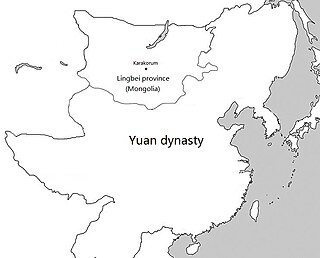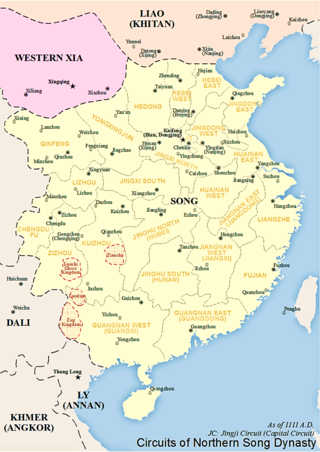Related Research Articles
The Battle of Xiangyang was a protracted series of battles between the Yuan dynasty and the Southern Song dynasty from 1267 to 1273. The battle was a significant victory for the Yuan dynasty and ended a 30-year defensive campaign waged by the Southern Song dynasty, allowing Yuan forces to advance into the Southern Song heartland. The capture of Xiangyang also allowed the Yuan dynasty to take control of the Han and Yangtze rivers, thereby depriving the Southern Song dynasty of two formidable natural barriers. The defeat devastated the Southern Song dynasty, which collapsed several years later at the Battle of Yamen.

Khanbaliq or Dadu of Yuan was the winter capital of the Yuan Dynasty of Mongols in what is now Beijing, the capital of Zhongguo (China) today. It was located at the center of modern Beijing. The Secretariat directly administered the Central Region of the Yuan Dynasty and dictated policies for the other provinces. Kublai and his successors also claimed supremacy over the entire Mongol Empire following the death of Möngke in 1259. Over time the unified empire gradually fragmented into a number of khanates.

Öljeytü Khan, born Temür, also known by his imperial Chinese temple name Emperor Chengzong of Yuan, was the second emperor of the Yuan dynasty of China, ruling from May 10, 1294 to February 10, 1307. Apart from Emperor of China, he is considered as the sixth Great Khan of the Mongol Empire, although it was only nominal due to the division of the empire. He was an able ruler of the Yuan dynasty, and his reign established the patterns of power for the next few decades.
This is a 'timeline of Taiwanese history', comprising important legal and territorial changes and political events in Taiwan and its predecessor states. To read about the background to these events, see History of Taiwan and History of the Republic of China. See also the list of rulers of Taiwan.

Four major military campaigns were launched by the Mongol Empire, and later the Yuan dynasty, against the kingdom of Đại Việt ruled by the Trần dynasty and the kingdom of Champa in 1258, 1282–1284, 1285, and 1287–88. The campaigns are treated by a number of scholars as a success due to the establishment of tributary relations with Đại Việt despite the Mongols suffering major military defeats. In contrast, modern Vietnamese historiography regards the war as a major victory against the foreign invaders.
Zhenjin, also rendered as Jingim, Chinkim, or Chingkim, was a crown prince of the Yuan dynasty of China. He was the son of Kublai Khan and grandson of Tolui.

The Yuan dynasty, officially the Great Yuan, was a Mongol-led imperial dynasty of China and a successor state to the Mongol Empire after its division. It was established by Kublai, the fifth khagan-emperor of the Mongol Empire from the Borjigin clan, and lasted from 1271 to 1368. In Chinese historiography, the Yuan dynasty followed the Song dynasty and preceded the Ming dynasty.

This is the timeline of the Mongol Empire from the birth of Temüjin, later Genghis Khan, to the ascension of Kublai Khan as emperor of the Yuan dynasty in 1271, though the title of Khagan continued to be used by the Yuan rulers into the Northern Yuan dynasty, a far less powerful successor entity, until 1634.

The Northern Yuan was a dynastic regime ruled by the Mongol Borjigin clan based in the Mongolian Plateau. It existed as a rump state after the collapse of the Yuan dynasty in 1368 and lasted until its conquest by the Jurchen-led Later Jin dynasty in 1635. The Northern Yuan dynasty began with the retreat of the Yuan imperial court led by Toghon Temür to the Mongolian steppe. This period featured factional struggles and the often only nominal role of the Great Khan.

Kublai, also known by his temple name as the Emperor Shizu of Yuan and his regnal name Setsen Khan, was the founder of the Yuan dynasty of China and the fifth khagan-emperor of the Mongol Empire from 1260 to 1294, although after the division of the empire this was a nominal position. He proclaimed the empire's dynastic name "Great Yuan" in 1271, and ruled Yuan China until his death in 1294.
The Yuan dynasty (1271–1368) was a dynasty of China ruled by the Mongol Borjigin clan. Founded by Kublai Khan, it is considered one of the successors to the Mongol Empire.

The Bureau of Buddhist and Tibetan Affairs, or Xuanzheng Yuan was a government agency of the Mongol-led Yuan dynasty of China to handle Buddhist affairs across the empire in addition to managing the territory of Tibet. It was originally set up by Kublai Khan in 1264 under the name Zongzhi Yuan or the "Bureau of General Regulation", before it was renamed in 1288.
The division of the Mongol Empire began when Möngke Khan died in 1259 in the siege of Diaoyu Castle with no declared successor, precipitating infighting between members of the Tolui family line for the title of khagan that escalated into the Toluid Civil War. This civil war, along with the Berke–Hulagu war and the subsequent Kaidu–Kublai war, greatly weakened the authority of the great khan over the entirety of the Mongol Empire, and the empire fractured into four khanates: the Golden Horde in Eastern Europe, the Chagatai Khanate in Central Asia, the Ilkhanate in Southwest Asia, and the Yuan dynasty in East Asia based in modern-day Beijing – although the Yuan emperors held the nominal title of khagan of the empire. The four divisions each pursued their own interests and objectives and fell at different times. Most of the western khanates did not recognize Kublai as Great Khan. Although some of them still asked Kublai to confirm the enthronement of their new regional khans, the four khanates were functionally independent sovereign states. The Ilkhanate and the Yuan dynasty had close diplomatic relations, and shared scientific and cultural knowledge, but military cooperation between all four Mongol khanates would never occur again — the united Mongol Empire had disintegrated.

The Yuan dynasty in Inner Asia was the domination of the Yuan dynasty in Inner Asia in the 13th and the 14th centuries. The Borjigin rulers of the Yuan came from the Mongolian steppe, and the Mongols under Kublai Khan established the Yuan dynasty (1271–1368) based in Khanbaliq. The Yuan was a Chinese dynasty that incorporated many aspects of Mongol and Inner Asian political and military institutions.

The Kaidu–Kublai war was a war between Kaidu and Kublai from 1268 to 1301. Kaidu was the leader of the House of Ögedei and the de facto khan of the Chagatai Khanate, while Kublai was the founder of the Yuan dynasty. The Kaidu–Kublai war followed the Toluid Civil War (1260–1264) and resulted in the permanent division of the Mongol Empire. By the time of Kublai's death in 1294, the Mongol Empire had fractured into four separate polities: the Golden Horde khanate in the northwest, the Chagatai Khanate in the middle, the Ilkhanate in the southwest, and the Yuan dynasty in the east based in modern-day Beijing. Although Temür later made peace with the three western khanates in 1304 after Kaidu's death, the four successor states of the Mongol Empire continued their own separate development and fell at different times.

The Yuan dynasty ruled over the Mongolian Plateau, including both Inner and Outer Mongolia as well as part of southern Siberia, between 1271 and 1368. The Mongolian Plateau is where the ruling Mongol Borjigin clan of the Yuan dynasty came from, thus it enjoyed a somewhat special status during the Yuan dynasty, although the capital of the dynasty had been moved from Karakorum to Khanbaliq since the beginning of Kublai Khan's reign, and Mongolia had been converted into a regular province, known as the Lingbei Province, by the early 14th century.

This is a timeline of the Song dynasty (960–1279). The Song dynasty was founded by Zhao Kuangyin, posthumously known as Emperor Taizu of Song, who ended the period of division known as the Five Dynasties and Ten Kingdoms period. The Song dynasty is commonly separated into two historical periods, the Northern Song (960–1127) and the Southern Song (1127–1279), divided by the loss of the north to the Jurchen Jin dynasty (1115–1234). In 1279, the Mongol Yuan dynasty conquered the Song.
This is a timeline of the Yuan dynasty (1271–1368). The Yuan dynasty was founded by the Mongol warlord Kublai Khan in 1271 and conquered the Song dynasty in 1279. The Yuan dynasty lasted nearly a hundred years before a series of rebellions known as the Red Turban Rebellion resulted in its collapse in 1368 and the rise of the Ming dynasty.

This is a timeline of the Ming dynasty (1368–1644) from the rise of the Hongwu Emperor to the rise and establishment of the Qing dynasty.

The military of the Yuan dynasty (1271–1368) were the armed forces of the Yuan dynasty, a fragment of the Mongol Empire that Kublai Khan established as a Mongol-led dynasty of China. The forces of the Yuan were based on the troops that were loyal to Kublai after the Division of the Mongol Empire in 1260. Initially, this force was a Tamma, a frontier army drawn from all Mongol tribes for conquest of China, which had no central organisation but was rather a loose collection of local warlords and Mongol princely armies. However, the army was gradually reformed by Kublai Khan into a more systematic force.
References
- ↑ Twitchett 1994, p. 458.
- ↑ Twitchett 1994, p. 457.
- ↑ Twitchett 1994, p. 434.
- ↑ Twitchett 1994, p. 464.
- ↑ Andrade 2008f.
- Andrade, Tonio (2008f), "Chapter 6: The Birth of Co-colonization", How Taiwan Became Chinese: Dutch, Spanish, and Han Colonization in the Seventeenth Century, Columbia University Press
- Twitchett, Denis (1994), The Cambridge History of China, Volume 6, Alien Regime and Border States, 907-1368, Cambridge: Cambridge University Press, ISBN 9780521243315